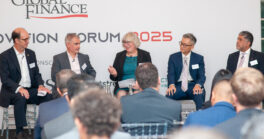Rohini Jain, CFO of business payments platform Bill, has strong views on how artificial intelligence is transforming the role of finance, the future of cross-border payments, and the challenges facing SMBs in today’s economic environment.
Global Finance: How is AI changing finance?
Rohini Jain: I’ve been in finance for over two decades. Very early on, roles were so much about bookkeeping and balancing the balance sheet and making sure the numbers were right, which evolved into finance support and decision making to support the CEO and the business teams.
Now finance is becoming the center of a lot—not only strategy-making in a business, but also executing on the strategy, driving accountability, creating the longer-term roadmaps. It’s really front and center running the business. Other than the CEO, the CFO is the only person who’s looking at every single function and who needs to know what they’re doing. I think AI becomes this amazing companion to a CFO that helps us accomplish much more, faster.
GF: Is AI changing opportunities for diverse leadership?
Jain: For people who are open to learning, it just gives us an immense number of tools to learn anything that we want very rapidly and grow into a role. People who are open to taking big step-up challenges, it’s become a little bit easier for them. The traditional education learning systems are not as critical as they were before.
As a woman, I have juggled my family—I want to be a primary homemaker for my kids and my husband and my family—but I also want to have an outstanding career. When I’m limited for time, I may not be able to go learn in a very structured environment. AI tools help people like us who must juggle a bunch of things to learn rapidly and really accelerate the path of growth.
GF: Bill serves small and mid-sized businesses. How do these SMBs use AI?
Jain: As we think about the use cases of AI that we want to create and distribute to SMBs, what is front and center is: what are the areas that are still the largest areas of friction in terms of SMBs managing their businesses?
For example, using AI to make a very modern and simple, almost seamless experience, that with access to a few things, we should be able to incorporate vendor history, what kind of bills you pay, and make it easy for someone who doesn’t like a lot of administrative tasks to get up and running. The important thing [for SMBs] is that data needs to be integrated across systems, and that’s where Bill really comes in.
GF: Are there specific areas where you think AI performs better than humans?
Jain: The AI models we are developing for our customers would help simplify workflow so much. For example, if you’re trying to run your business and you have a bill that usually happens on the second week of every month, we would have our AI agent that is watching all this and saying, oh, it looks like you did not pay this bill on the second week of this month. Do you want me to pay it? The best funding instrument for you to pay this bill will be so and so credit card, because you get X number of points.
Or, I think you should pay this bill four days later instead of paying it today, because that will maximize your cash flow. There are a lot of variables to be able to make that decision. The AI tools in some regards are more able to take care of all those variables than a human could.
GF: What AI risks keep you up at night?
Jain: Probably similar concerns to yours. If I think about it, 2030, years down the line, where does it all end? It is not clear. How does the economy develop where the productivity is so high of the individuals that we fully reap the benefits of AI while making sure we have the right employment levels within each country, and we continue to drive prosperity across the board.
The divide between the economies—where there are some people who have more control of the money versus others—should not increase. I worry a little bit about that. We just don’t know what we don’t know, and it’s hard to put proper regulation and control around it. So, if we are thoughtful and we are trying to use AI in the right ways, and the regulation keeps up with that, I think there are probably more positive outcomes than negative.
GF: Let’s turn to blockchain technology. How do you see it changing payments?
Jain: Blockchain has so much potential, but I feel that it may not have the same adoption curve [as AI]. Blockchain has today, in my mind, more specific use cases. One that immediately comes to mind is cross-border transactions. They are expensive. They’re tedious. There’s a lot of friction. Blockchain has a capability—with stablecoin exchanges—that can really bring down the cost [of transactions]. There are some exotic currencies that it’s just hard to get everybody to have the confidence to trade in. Stablecoin can help increase trade with those currencies that are more exotic.
GF: You mention crypto and exotic currencies, but what are the benefits to holding stablecoin over the US dollar?
Jain: There are pros and cons. There are some advantages to the stablecoin, and one of them is that there isn’t much regulation around it so it gives flexibility.
GF: How are tariffs and economic conditions affecting SMBs?
Jain: There are several key themes right now that are impacting the SMBs. Number one is consumer demand and consumer confidence. How much are people really wanting to spend? The second thing top of mind for everybody is tariffs. There was, for a long period of time, uncertainty around tariffs. Now that is behind us.
There is certainty around tariffs. People are starting to see it show up in their expenses. The interesting thing, and not fully unexpected, is that not all the tariff spend is being passed on to consumers—especially among the larger enterprises, which are very equipped to absorb a large part of those costs. SMBs, they are forced to absorb parts of that [cost], which is taking a bite out of their wallet and what they can spend on other things.
GF: Are there encouraging signs in the economy?
Jain: I’m hoping that the SMBs get some relief from a cash-flow perspective. There are some things that will help them–deductions that are allowed, which will put a little bit more money back in the SMBs. What they’re then looking for from the fintechs is to make operations simple and to help them make the right decisions to optimize their cash flows.
GF: How do you compete with large banks entering your space?
Jain: All customers—and SMBs especially—are looking for very integrated solutions. They don’t want to have 10 different businesses that provide them service A, B, C. Your data gets really fragmented; you cannot harness the full power of all the data that’s flowing through all these different systems. You must maintain different contracts. You’re paying a whole bunch of people. You’re integrating your technology into multiple platforms, and it’s just huge overhead. It’s been a big strategy for Bill—our first embedded solution, which we call the 1.0, was with financial institutions.
We gained a lot of experience in what the customers of these financial institutions really need. We’ve been honing the product. Banks are very good at doing payments. They may not be as good at providing software services which are just seamless, simple, easy user interface and add a lot of value to the businesses. We’ve seen a lot of success with our financial insitutions embeded channels.
GF: Where do you see areas of growth?
Jain: One of the areas we are focusing on is the Embed 2.0 strategy, where we are applying all the learnings of the first embedded version and [decide] we are going to partner with a much wider set. We recently announced our Paychex partnership. We want to meet our customers where they are. If Paychex customers are already using that system, they will be able to now integrate Bill services seamlessly. We hope to announce another Fortune 500 partnership very soon, which will give us access to a lot of upper small businesses and lower mid-market clients.
GF: Bill has been active in M&A. How are you thinking about opportunities?
Jain: I was reading a study several weeks ago that at best, 50% of M&As are successful. The way to think about it is, do you build, buy, or partner? Leaders used to always think about build or buy. Partner is becoming an important third way of looking at where you want to go. I always think that M&A as a tool for talent acquisition is excellent, but you must be very clear about why you’re doing it. How does it plug and play into your organization from a cultural fit as well as skill set? Large M&A is fraught with a lot of risks, and there needs to be a very, very compelling case to think about that.




